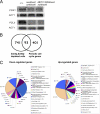G1/S transcription factor orthologues Swi4p and Swi6p are important but not essential for cell proliferation and influence hyphal development in the fungal pathogen Candida albicans
- PMID: 21257795
- PMCID: PMC3067467
- DOI: 10.1128/EC.00278-10
G1/S transcription factor orthologues Swi4p and Swi6p are important but not essential for cell proliferation and influence hyphal development in the fungal pathogen Candida albicans
Abstract
The G(1)/S transition is a critical control point for cell proliferation and involves essential transcription complexes termed SBF and MBF in Saccharomyces cerevisiae or MBF in Schizosaccharomyces pombe. In the fungal pathogen Candida albicans, G(1)/S regulation is not clear. To gain more insight into the G(1)/S circuitry, we characterized Swi6p, Swi4p and Mbp1p, the closest orthologues of SBF (Swi6p and Swi4p) and MBF (Swi6p and Mbp1p) components in S. cerevisiae. The mbp1Δ/Δ cells showed minor growth defects, whereas swi4Δ/Δ and swi6Δ/Δ yeast cells dramatically increased in size, suggesting a G(1) phase delay. Gene set enrichment analysis (GSEA) of transcription profiles revealed that genes associated with G(1)/S phase were significantly enriched in cells lacking Swi4p and Swi6p. These expression patterns suggested that Swi4p and Swi6p have repressing as well as activating activity. Intriguingly, swi4Δ/Δ swi6Δ/Δ and swi4Δ/Δ mbp1Δ/Δ strains were viable, in contrast to the situation in S. cerevisiae, and showed pleiotropic phenotypes that included multibudded yeast, pseudohyphae, and intriguingly, true hyphae. Consistently, GSEA identified strong enrichment of genes that are normally modulated during C. albicans-host cell interactions. Since Swi4p and Swi6p influence G(1) phase progression and SBF binding sites are lacking in the C. albicans genome, these factors may contribute to MBF activity. Overall, the data suggest that the putative G(1)/S regulatory machinery of C. albicans contains novel features and underscore the existence of a relationship between G(1) phase and morphogenetic switching, including hyphal development, in the pathogen.
Figures






Similar articles
-
Coordinated regulation of gene expression by the cell cycle transcription factor Swi4 and the protein kinase C MAP kinase pathway for yeast cell integrity.EMBO J. 1996 Sep 16;15(18):5001-13. EMBO J. 1996. PMID: 8890173 Free PMC article.
-
A forkhead transcription factor is important for true hyphal as well as yeast morphogenesis in Candida albicans.Eukaryot Cell. 2002 Oct;1(5):787-98. doi: 10.1128/EC.1.5.787-798.2002. Eukaryot Cell. 2002. PMID: 12455696 Free PMC article.
-
The mating projections of Saccharomyces cerevisiae and Candida albicans show key characteristics of hyphal growth.Fungal Biol. 2011 Jun;115(6):547-56. doi: 10.1016/j.funbio.2011.02.001. Epub 2011 Feb 24. Fungal Biol. 2011. PMID: 21640318
-
The protein secretory pathway of Candida albicans.Mycoses. 2009 Jul;52(4):291-303. doi: 10.1111/j.1439-0507.2008.01673.x. Epub 2009 Jan 21. Mycoses. 2009. PMID: 19207839 Review.
-
Histone deacetylase-mediated morphological transition in Candida albicans.J Microbiol. 2015 Dec;53(12):805-11. doi: 10.1007/s12275-015-5488-3. Epub 2015 Dec 2. J Microbiol. 2015. PMID: 26626350 Review.
Cited by
-
Identification and characterization of antifungal compounds using a Saccharomyces cerevisiae reporter bioassay.PLoS One. 2012;7(5):e36021. doi: 10.1371/journal.pone.0036021. Epub 2012 May 4. PLoS One. 2012. PMID: 22574132 Free PMC article.
-
Pph3 dephosphorylation of Rad53 is required for cell recovery from MMS-induced DNA damage in Candida albicans.PLoS One. 2012;7(5):e37246. doi: 10.1371/journal.pone.0037246. Epub 2012 May 14. PLoS One. 2012. PMID: 22606354 Free PMC article.
-
Transcription Activator Swi6 Interacts with Mbp1 in MluI Cell Cycle Box-Binding Complex and Regulates Hyphal Differentiation and Virulence in Beauveria bassiana.J Fungi (Basel). 2021 May 25;7(6):411. doi: 10.3390/jof7060411. J Fungi (Basel). 2021. PMID: 34070348 Free PMC article.
-
The evolution of a G1/S transcriptional network in yeasts.Curr Genet. 2018 Feb;64(1):81-86. doi: 10.1007/s00294-017-0726-3. Epub 2017 Jul 25. Curr Genet. 2018. PMID: 28744706 Review.
-
Transcriptional Control of Drug Resistance, Virulence and Immune System Evasion in Pathogenic Fungi: A Cross-Species Comparison.Front Cell Infect Microbiol. 2016 Oct 20;6:131. doi: 10.3389/fcimb.2016.00131. eCollection 2016. Front Cell Infect Microbiol. 2016. PMID: 27812511 Free PMC article. Review.
References
-
- Andaluz E., Ciudad T., Gomez-Raja J., Calderone R., Larriba G. 2006. Rad52 depletion in Candida albicans triggers both the DNA-damage checkpoint and filamentation accompanied by but independent of expression of hypha-specific genes. Mol. Microbiol. 59:1452–1472 - PubMed
-
- Bachewich C., Nantel A., Whiteway M. 2005. Cell cycle arrest during S or M phase generates polarized growth via distinct signals in Candida albicans. Mol. Microbiol. 57:942–959 - PubMed
Publication types
MeSH terms
Substances
Grants and funding
LinkOut - more resources
Full Text Sources
Molecular Biology Databases

